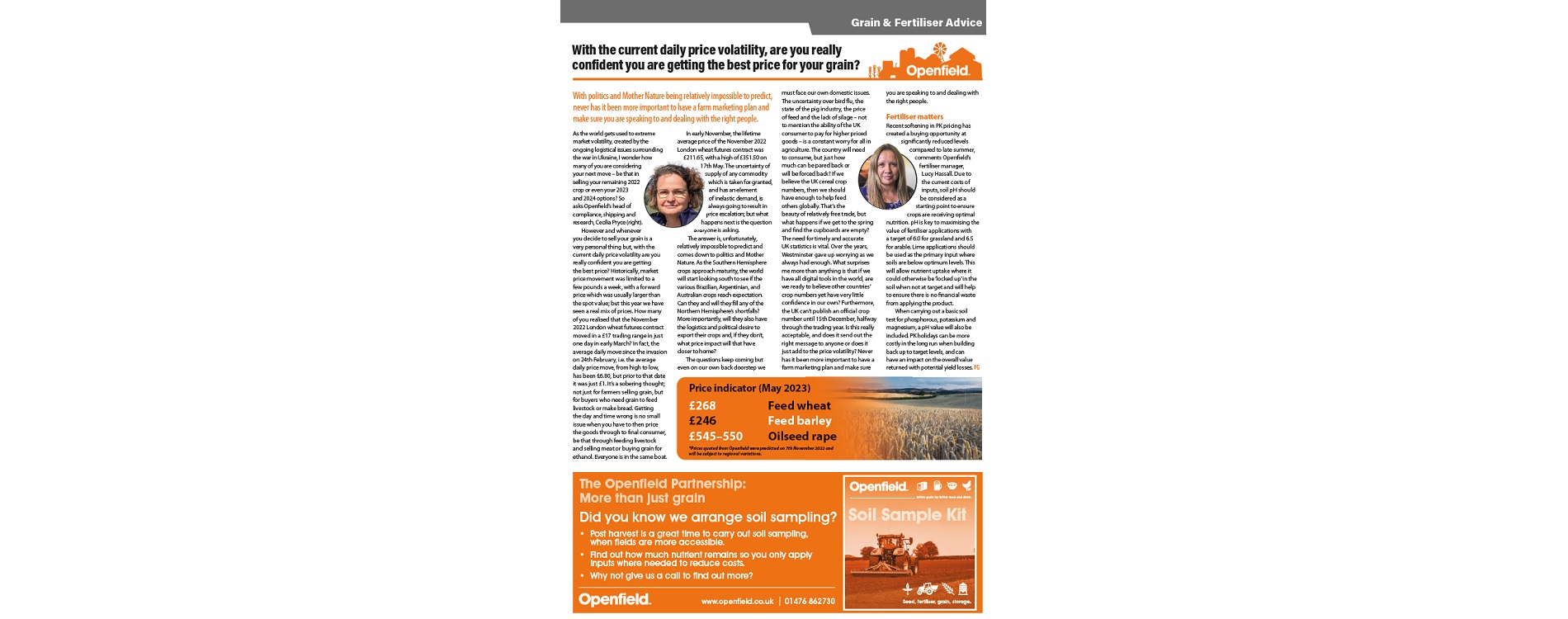With the current daily price volatility, are you really confident you are getting the best price for your grain?
With politics and Mother Nature being relatively impossible to predict, never has it been more important to have a farm marketing plan and make sure you are speaking to and dealing with the right people.
As the world gets used to extreme market volatility, created by the ongoing logistical issues surrounding the war in Ukraine, I wonder how many of you are considering your next move – be that in selling your remaining 2022 crop or even your 2023 and 2024 options? However and whenever you decide to sell your grain is a very personal thing but, with the current daily price volatility are you really confident you are getting the best price? Historically, market price movement was limited to a few pounds a week, with a forward price which was usually larger than the spot value; but this year we have seen a real mix of prices. How many of you realised that the November 2022 London wheat futures contract moved in a £17 trading range in just one day in early March? In fact, the average daily move since the invasion on 24th February, i.e. the average daily price move, from high to low, has been £6.80, but prior to that date it was just £1. It’s a sobering thought; not just for farmers selling grain, but for buyers who need grain to feed livestock or make bread. Getting the day and time wrong is no small issue when you have to then price the goods through to final consumer, be that through feeding livestock and selling meat or buying grain for ethanol. Everyone is in the same boat.
In early November, the lifetime average price of the November 2022 London wheat futures contract was £211.65, with a high of £351.50 on 17th May. The uncertainty of supply of any commodity which is taken for granted, and has an element of inelastic demand, is always going to result in price escalation; but what happens next is the question everyone is asking. The answer is, unfortunately, relatively impossible to predict and comes down to politics and Mother Nature. As the Southern Hemisphere crops approach maturity, the world will start looking south to see if the various Brazilian, Argentinian, and Australian crops reach expectation. Can they and will they fill any of the Northern Hemisphere’s shortfalls? More importantly, will they also have the logistics and political desire to export their crops and, if they don’t, what price impact will that have closer to home? The questions keep coming but even on our own back doorstep we must face our own domestic issues. The uncertainty over bird flu, the state of the pig industry, the price of feed and the lack of silage – not to mention the ability of the UK consumer to pay for higher priced
goods – is a constant worry for all in agriculture. The country will need to consume, but just how much can be pared back or will be forced back? If we believe the UK cereal crop numbers, then we should have enough to help feed others globally. That’s the beauty of relatively free trade, but what happens if we get to the spring and find the cupboards are empty?
The need for timely and accurate UK statistics is vital. Over the years, Westminster gave up worrying as we always had enough. What surprises me more than anything is that if we have all digital tools in the world, are we ready to believe other countries’ crop numbers yet have very little confidence in our own? Furthermore, the UK can’t publish an official crop number until 15th December, halfway through the trading year. Is this really acceptable, and does it send out the right message to anyone or does it just add to the price volatility? Never has it been more important to have a farm marketing plan and make sure you are speaking to and dealing with the right people.
Fertiliser matters
Recent softening in PK pricing has created a buying opportunity at significantly reduced levels compared to late summer. Due to the current costs of inputs, soil pH should be considered as a starting point to ensure crops are receiving optimal nutrition. pH is key to maximising the value of fertiliser applications with a target of 6.0 for grassland and 6.5 for arable. Lime applications should be used as the primary input where soils are below optimum levels. This will allow nutrient uptake where it could otherwise be ‘locked up’ in the soil when not at target and will help to ensure there is no financial waste from applying the product.
When carrying out a basic soil test for phosphorous, potassium and magnesium, a pH value will also be included. PK holidays can be more costly in the long run when building back up to target levels, and can have an impact on the overall value returned with potential yield losses.




